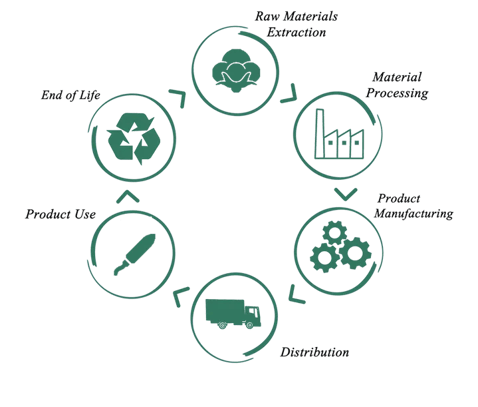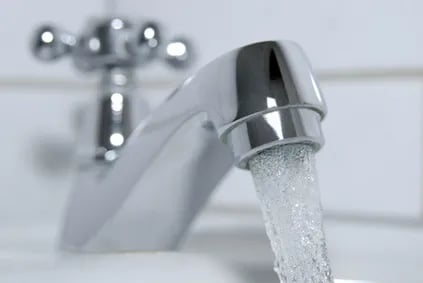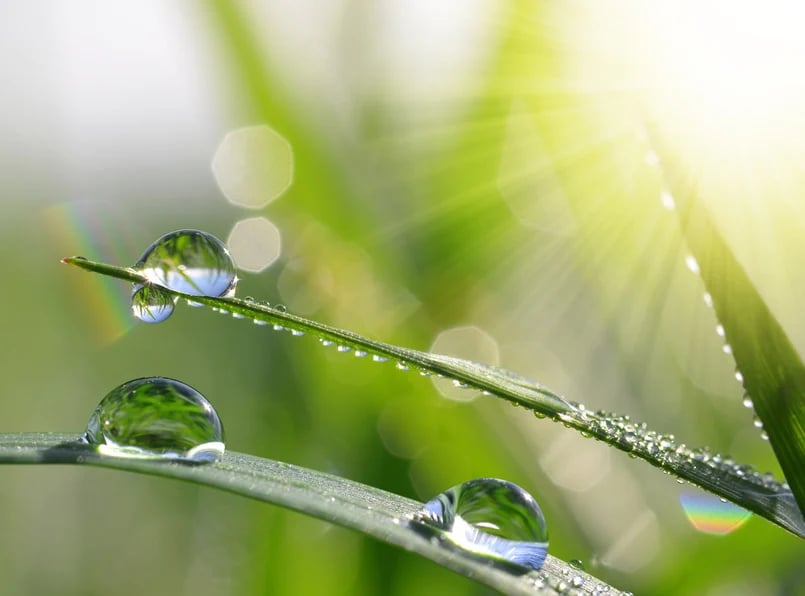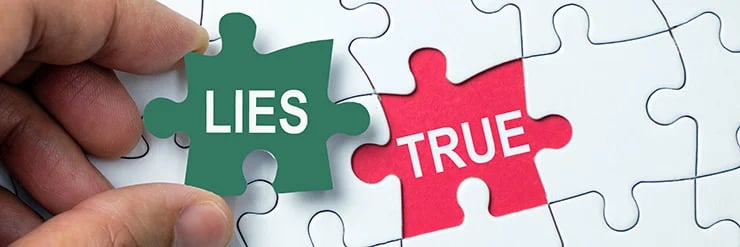An LCA comparing menstrual cups and tampons shows that products advertised as particularly sustainable are not always the truly sustainable alternative. A second look is worthwhile and sharpens sustainability thinking.
In addition to tampons and sanitary pads, menstrual cups are increasing in popularity. The motivation behind this is the desire to implement a sustainable lifestyle in monthly menstrual hygiene as well. The most common argument is that menstrual cups, unlike tampons, can be used several times. For this reason, manufacturers and the media often describe the cups as a more sustainable alternative to tampons. This perception has now established itself in public opinion. But is this really the case? Are the cups actually more ecologically sustainable [1] or are they rather a so-called “green lie”?

Does the statement “menstrual cups are more sustainable” constitute a “green lie”?
If the perceived environmental sustainability of a product does not correspond to the actual environmental sustainability, this is referred to as a so-called green lie. A statement of this kind does not necessarily mean that the truth is knowingly covered up or glossed over; it can also arise unknowingly – for example, due to incomplete or outdated information (see article Do LCAs reveal green lies).
Life cycle assessments (LCA) are carried out in order to answer precisely the question of whether product A is more environmentally sustainable than product B. The comparison of a one-way versus a reusable system is one of the classic cases in life cycle assessment: There are many examples from the beverage packaging sector where one-way and reusable systems have been examined. The term “system” already gives an indication that this is not a trivial consideration: After all, not only the pure product, i.e. the container, the cup, the tampon, is considered, but also the entire life cycle of the product and thus all activities that contribute to fulfilling a function. The function in the example of menstrual products is to provide menstrual hygiene for one year for a person with an average menstruation.
In the disposable tampon system, a large number of tampons (including production, packaging and transport) and their disposal are necessary to fulfil the function. In the reusable system of menstrual cups, only 1/5 of a cup is needed for one year (one year by five years lifetime of the cup). For hygienic reasons, however, the cup must be cleaned regularly with soap and water and boiled for disinfection.

So which product is more environmentally friendly?
If you don’t include cup cleaning in the weighing process, the answer to the question of the environmental friendliness of the two alternatives is quickly done: Over 200 tampons (and the waste they generate) are compared to just one small cup that can be used over and over again over a long period of time. Prematurely, manufacturers and consumers conclude that the cups must be better. But appearances are deceptive, because it is not quite that simple.
It is comparable to the discussion about electric cars. The initial euphoria about the supposedly environmentally friendly car has had to give way to the reality that environmental friendliness depends, among other things, heavily on the energy mix used to charge the car (see article “Is e-mobility a truly sustainable solution?“). The same problem currently occurs with the evaluation of menstrual cups – considering the cleaning is unusual for the consumer and therefore it is largely ignored in an intuitive evaluation. If you do the calculation and analyze the usage, the activities to guarantee a safe reusability of the cup account for over 90% of the environmental impacts. Disregarding these factors is therefore almost negligent.
How is the cleaning of the cups sufficiently taken into account?
If cleaning is to be adequately considered, many factors must be taken into account, such as the amount of water used to rinse the cups. However, this supposedly simple information is very complex to determine. There are no representative public studies on the quantities of water used or recommended for hygienic reasons. Nor do the manufacturers provide any quantity data on this subject or make any specific recommendations. A consumer survey conducted specifically for the life cycle assessment includes an estimate of the quantities of water used by cup users. However, the quantities stated vary considerably. The manufacturer’s specifications on the frequency and duration of disinfecting the cups by boiling them also fluctuate – and thus also the result of the life cycle assessment.

What consequences do these strong fluctuations have for the interpretation of the results of a life cycle assessment?
In order to be able to make a statement as to whether an alternative is better or worse in comparison, strong fluctuations must be put into perspective, i.e. the distance between the calculated results must be large enough to absorb these fluctuations. This necessary distance was set at 80% in the comparison of tampons and menstrual cup. In concrete terms, this means that if the results differ from each other by, say, 30%, they are still interpreted as equivalent. Why? A change e.g. in the amount of water used to rinse the cups (which is a great uncertainty) would immediately tilt the result in one direction or the other. If one only looks at the absolute figures, a wrong interpretation can easily be made without considering these significance limits (one reason for refraining from publicating the numbers).
The assessment becomes even more complex if not only one figure is interpreted as the result, but several so-called impact categories are juxtaposed (e.g. climate change, use of agricultural land, depletion of fossil resources, etc.). It is therefore possible that a clear advantage for an alternative is calculated for certain environmental impacts (distance greater than 80%, the so-called significance threshold), but a clear disadvantage is calculated for other environmental impacts. LCA experts refer to this as a trade-off. In the case of so-called trade-offs, a conflict of objectives arises as to which environmental good is classified as more worthy of protection, e.g. to what extent resource protection is more important than climate protection. By weighting individual environmental impacts, a kind of ranking could be established. However, due to the uncertain data situation and the risk of a very subjective consideration, this was not carried out.
Are the statements about the sustainability of menstrual cups therefore a “green lie”?
Yes. On the basis of the life cycle assessment carried out, it was clearly shown that the perception of the general public that menstrual cups are the more ecologically sustainable product is not correct in this blanket statement. However, it cannot be claimed that tampons are the more environmentally sustainable product. The answer is: it depends. As so often, there is no black or white, but many nuances in between.
Menstrual cups are still a young product on the market. We assume that a more distinct user behavior will establish itself, for example by communicating a hygiene standard for cleaning and for the frequency of changing the cups. This development would lead to a better data situation, less uncertainty and thus a more unambiguous result for one of the alternatives. Until then, the question remains open as to which alternative is more environmentally friendly.
What is the contribution of LCA to the sustainability discourse?
In the case of an uncertain data situation, a life cycle assessment cannot always provide clear statements as to which product is (unambiguously) more ecologically advantageous. Nevertheless, the analysis serves an important purpose:
- The systematic consideration of the life cycle of product systems enables a fair comparison and avoids environmental impacts being shifted from one phase of the product’s life to another and thus possibly being overlooked in perception (so-called burden shifting). In our example, a small amount of material is used in the manufacture of the menstrual cups, but high costs are incurred in cleaning them during the use phase.
- The life cycle assessment also shows which aspects have the greatest influence on the results. For the menstrual cups this is the cleaning behavior of the users.
- This study helps to uncover false assumptions and to sensitize the users, in order to ultimately enhance sustainability awareness and train our way of thinking with a life cycle perspective.

Note: This study was conducted by ifu Hamburg GmbH commissioned by Johnson & Johnson GmbH. In order to ensure that tampons are not preferred in any way, all assumptions included in the data basis were based on values favourable for menstrual cups to ensure the most robust and fair consideration possible. In addition, an independent external panel of experts critically monitored the study, reviewed the results and confirmed that the study was conducted in accordance with the ISO 14040/44 standard. This procedure is described in the ISO standard as “critical review” and is mandatory if comparative statements on product systems are to be published.
[1] According to the United Nations Environment Programme (UNEP 2017 – UNEP Guidelines for Providing Product Sustainability Information), multi-dimensionality (ecological, social and economic) must be taken into account when communicating information on product sustainability. Among other things, individual results (e.g. less greenhouse gas emissions) must not be used to generally describe a product as “more sustainable”. The term “more sustainable” is therefore per se generalized and thus incorrect. In order not to disrupt the reading flow of the article, we will talk about ecological sustainability or environmental friendliness in the following, knowing full well that this is also a generalization.




.png)

